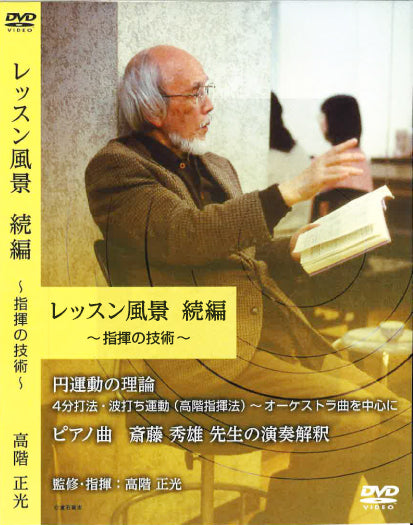PAMD-1404 ¥5,500 (tax included)
Quoted from the DVD description
This DVD is centered on practice with an orchestral piece of the 4-minute batting method and wave movement from the conducting course development.
The four-minute batting method has its origin in the Saito commanding method's three-beat batting method (Waltz batting method), and has the principle of circular motion. The 4-minute hitting method is to insert the 4-division notch into the ichitowo and circular motion. The undulating motion draws an extremely flat elliptical shape with a pre-point motion that gently pushes forward and a post-point motion that pulls back on almost the same path. After counting ichitowo, the fist returns to the abdominal position while decelerating.
Elbows almost touch the body. Pulling up from this position is a spring-up. It becomes a linear movement that goes up and down, and the two techniques are very similar in this way. The use of the 4- minute stroke method is effective for creating a flowing rhythm with small figures. Also, if you hit it hard and softly, it will bring out a sharp accent sound, but the rebounding movement after the performance is important, and by inserting it into the tempo, you can sustain the hint of tempo .
Saito Sensei's interpretation of the performance is our starting point, so we will choose from the piano pieces and keep them for reference.
Program
1 DVD 97 minutes[Beethoven: Symphony No. 7, 1st movement]Beethoven symphony No.7, Op.92 : mov.1
Double strike, average movement, quarter stroke first entry, split first entry, horizontal first entry, wavy movement
[Beethoven: Symphony No. 4, 1st Movement]Beethoven symphony No.4, Op.60 : mov.1
Spring, wave movement, pre-in, double strike
[Beethoven: Symphony No. 3, 1st movement]Beethoven symphony No.3, Op.55 : mov.1
3 time beats, hooks, hemiola
[Beethoven: Symphony No.9, 3rd movement]Beethoven symphony No.9, Op.125 : mov.3
3 time signature Hanage, 12/8 time division method
[Beethoven: Symphony No.5, 3rd movement]Beethoven symphony No.5, Op.67 : mov.3
Scherzo hitting method, scherzo preemptive method, division, scherzo hitting method bounce, double strike
[Beethoven: Egmont Overture] Beethoven Egmont Overture, Op.84
3-beat, 4-minute, 3-beat, 2-step, 3-beat, sf-beat, 2-step, 4-minute
[Brahms: Symphony No. 1, 1st Movement]Brahms Symphony No. 1 Op. 68 : mov.1
Introductory part, waving movement, gathering part, tripartite rhythm
[Brahms: Symphony No. 1, 2nd Movement]Brahms Symphony No. 1 Op. 68 : mov.2
Average exercise, undulating exercise (average exercise, swing, hook), triplet swing, quarter stroke, split method
[Brahms: Symphony No. 3, 1st Movement]Brahms Symphony No. 3 Op. 90 : mov.1
3 beats, 3 beats hook, 3 beats shakui
[Sibelius: Symphony No. 2, 1st Movement]Sibelius: Symphony No.2 Op.43:mov.1
3-beat system hooking/shakui, 3-beat hitting method, wave movement, split first
[Mendelssohn: From Fingal's Cave] Mendelssohn Fingal's Cave Op.
Wave motion, average motion, shakui, 4-minute stroke
[Dvorak: Symphony No. 9, 1st movement] Dvok: Symphony No. 9 :mov.1
Waving motion, hooking, sf tapping, A division (with hooking added), B division
Bruckner - Symphony No. 7 :mov.2
Wave movement, A division, B division, double strike
[Haydn: Symphony No. 100, 1st Movement] Haydn - Symphony No. 100
Waving exercise (average exercise, shakui), division method, preemptive method, quarter stroke method
[Mozart: Symphony No. 35, 1st Movement] Mozart - Symphony No. 35 KV385 : mov.1
4-minute batting method, 4-minute batting division pre-in, 4-minute batting hooking, spring-up (4 divisions)
[Rossini: Barber of Seville Overture]
Double strike, split, split first, 4-minute hit system hook, 4-minute hit
[Tea time] Tea time
[Piano from Schumann: Childhood Scenes]Schumann Kinderszenen
[Mendelssohn: Songs Without Words] mendelssohn songs without words
[Beethoven: Piano Sonata "Pathetique"]
Jumping, hooking, wave movement, triple beat, 9/8 beat (three beats per beat in a three beat pattern), division method, A division, B division
Profile
Takashina MasamitsuBorn December 27, 1925 in Tokyo.
Lecturer at Toho Gakuen College, Toho Gakuen Junior College, member of the Japan Conductors Association.
Studied conducting under Professor Hideo Saito. He later worked as an assistant at the Saito Conducting School.
He presided over the Takashina Conducting School and devoted himself to the succession and spread of the Saito Conducting Method.
Over the years, he has accumulated achievements as a commanding instructor, and from his disciples, Norichika Iimori, Noh Imamura, Takuo Tamura, Kiyotaka Teraoka, Naohiro Totsuka, Fujio Furuhashi, Keiko Mitsuhashi, Takuo Yuasa, etc. It produces conductors who are active in
Theory of techniques in the field of 1 beat 4 divisions (four-minute beats, wave movement, etc.) based on the principle of circular motion in the "Complete Guide to Conducting" (Ongaku no Tomosha), which summarizes Saito's conducting method. was established. (2011 [10th edition])
This was the establishment of the Higher Order Command Law.


